Ecommerce is a competitive field to be involved in, and it can be difficult for some entrepreneurs to assess how successful their businesses are. When you’re assessing the success of your store you may opt to analyze the amount of sales which you’ve made, the amount of revenue your store has generated, or the number of products which you’ve sold. These are all great metrics to measure, but there are a lot more statistics which are valuable when you’re running an ecommerce business, some of which are only available with Google Analytics. With Google Analytics you’ll be able to gather data about your store, and be able to better analyze how successful your store is.
We’ve created this article to help you understand how you can use Google Analytics to help your ecommerce business grow. At the end of this article you’ll have a strong grasp of the metrics which are important to measure for your ecommerce business, and you’ll know exactly how you can measure them yourself.
Let’s go!
Post Contents
Why is Google Analytics Important for Your Business?

Google Analytics is a vital tool for your ecommerce business, as it offers you the chance to obtain and analyze in-depth statistics about who your customers are, what they’re interested in, and how the interact with your online store. When you take advantage of the wealth of information which Google Analytics offers you can make data-informed decisions about the best ways to improve your ecommerce store. You’ll be able to validate any theories which you have about your business, instead of acting on instinct.
How to Create an Ecommerce Report on Google Analytics
Now that we’ve covered the value that Google Analytics can bring to your ecommerce business, it’s time to integrate the tool into your store.
The first step in this process is enabling ecommerce reports on Google Analytics, and your Shopify store. This feature isn’t automatically enabled when you create a store on Shopify, you’ll need to set this manually. You can do this by adding a small line of code into your Shopify store’s settings — don’t worry, it’s easier than it sounds, and you can find a full guide here.
Once you’ve added this code into your Shopify settings you’ll need to login to your ecommerce business’ Google Analytics page. From here select ‘Admin’, and then select the correct view (this will likely correspond with the name of your website).
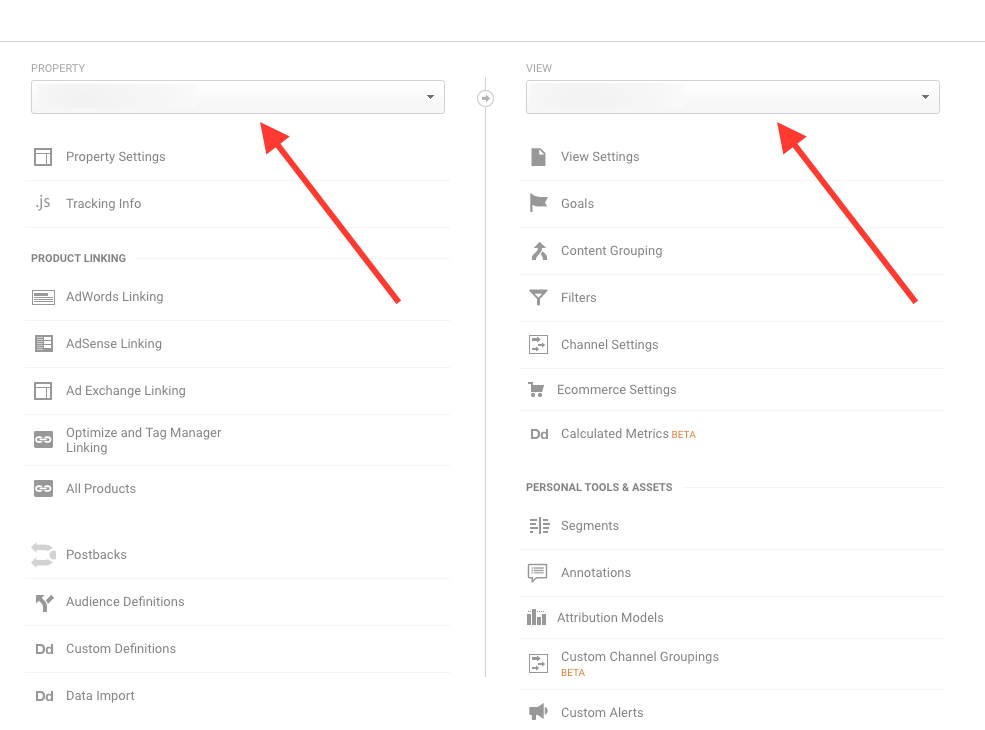
Once you’ve selected the view which corresponds with your ecommerce business it’s time to select ‘Ecommerce Settings’, and click enable.
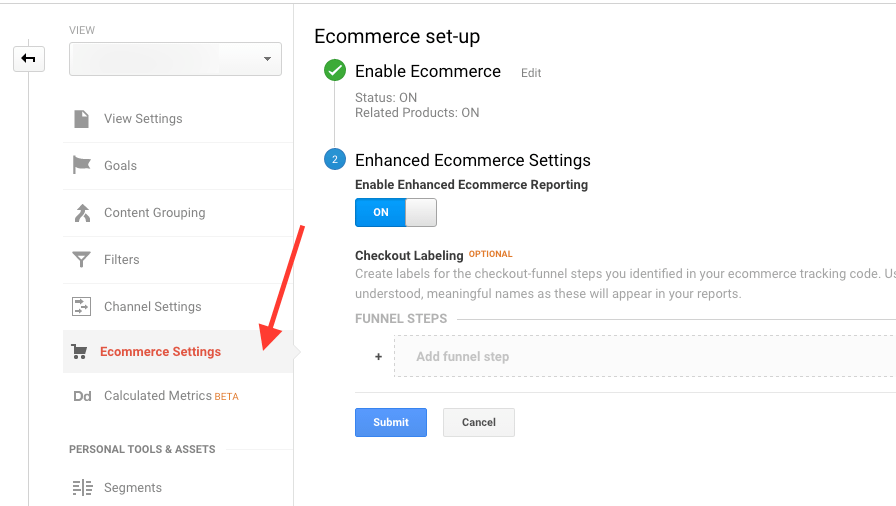
Once you’ve enabled ecommerce reports you’ll start cataloguing data from your ecommerce store’s activity. We recommend waiting a couple of days after this step so you’ll be able to build a bank of data which you can then use to gain a deeper understanding of your ecommerce store. Remember, if you can’t see your store’s data, you can’t optimize it.
Understanding Demographics
Now that you’ve enabled your ecommerce reports it’s time to start analyzing your store’s data. An important metric which you can analyze is the demographic of your customers — specifically the behaviour of Males vs Females with your store. You can access this information by selecting the ‘Acquisition’ tab at the side bar of Google Analytics, and then selecting ‘Demographics’ and ‘Male / Female’.
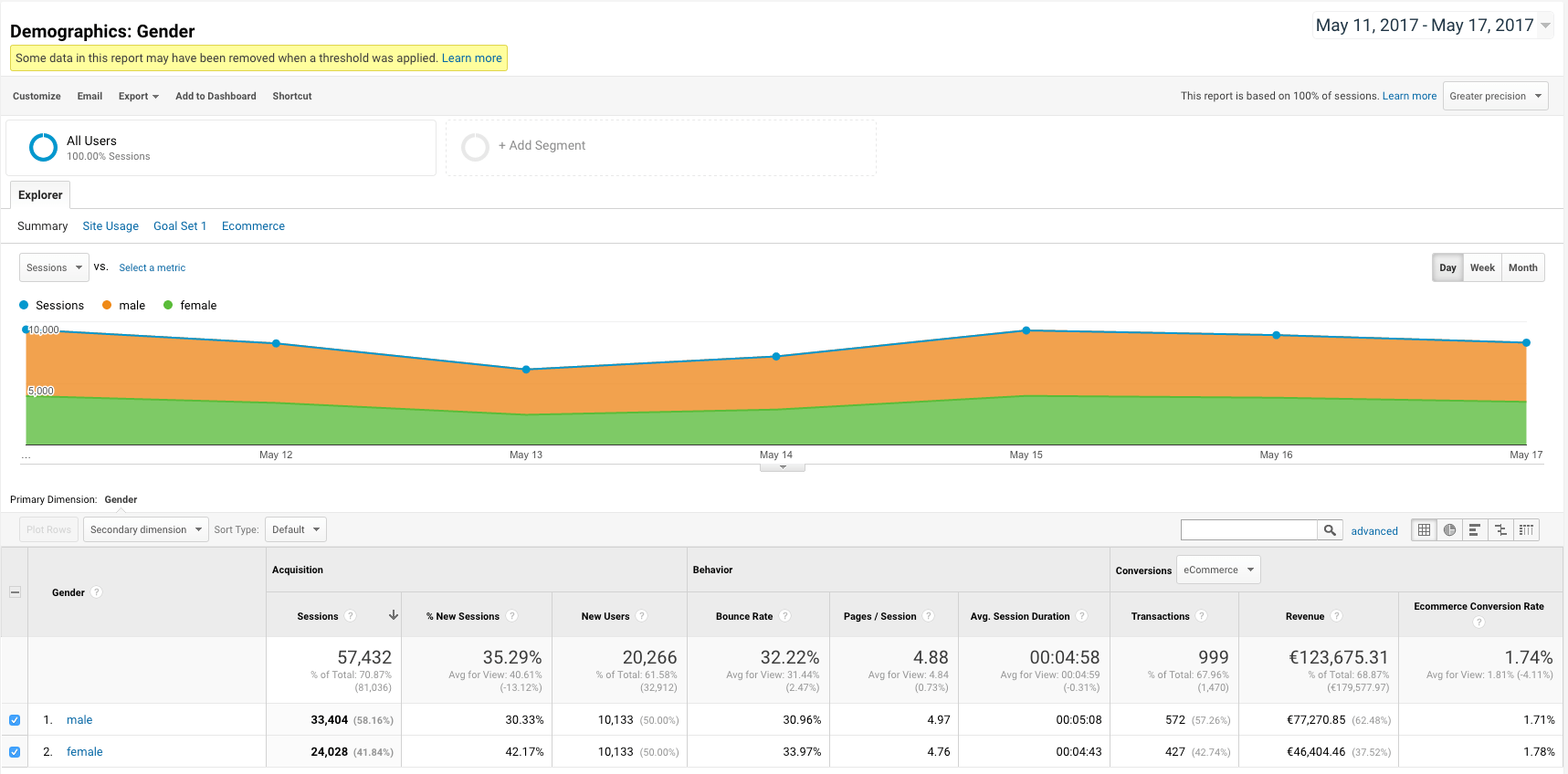
When you analyze your store’s visitors on a Male / Female basis you’ll gain some valuable insights about your ecommerce business. You may find that men are purchasing more products from your store than women are, which could affect the marketing campaigns which you have in place and help you gain more conversions. You may find that women may have less orders, but have contributed to a larger percentage of the store’s overall revenue. Use this information to adjust and improve your ecommerce store, and your business will continue to grow and generate more revenue in the future.
Understanding Customer Behavior
Another section in the ‘Acquisition’ tab which you may be interested in is ‘Behavior’ — this will help you to better understand your customers. The most useful tab here would be ‘New vs Returning’.
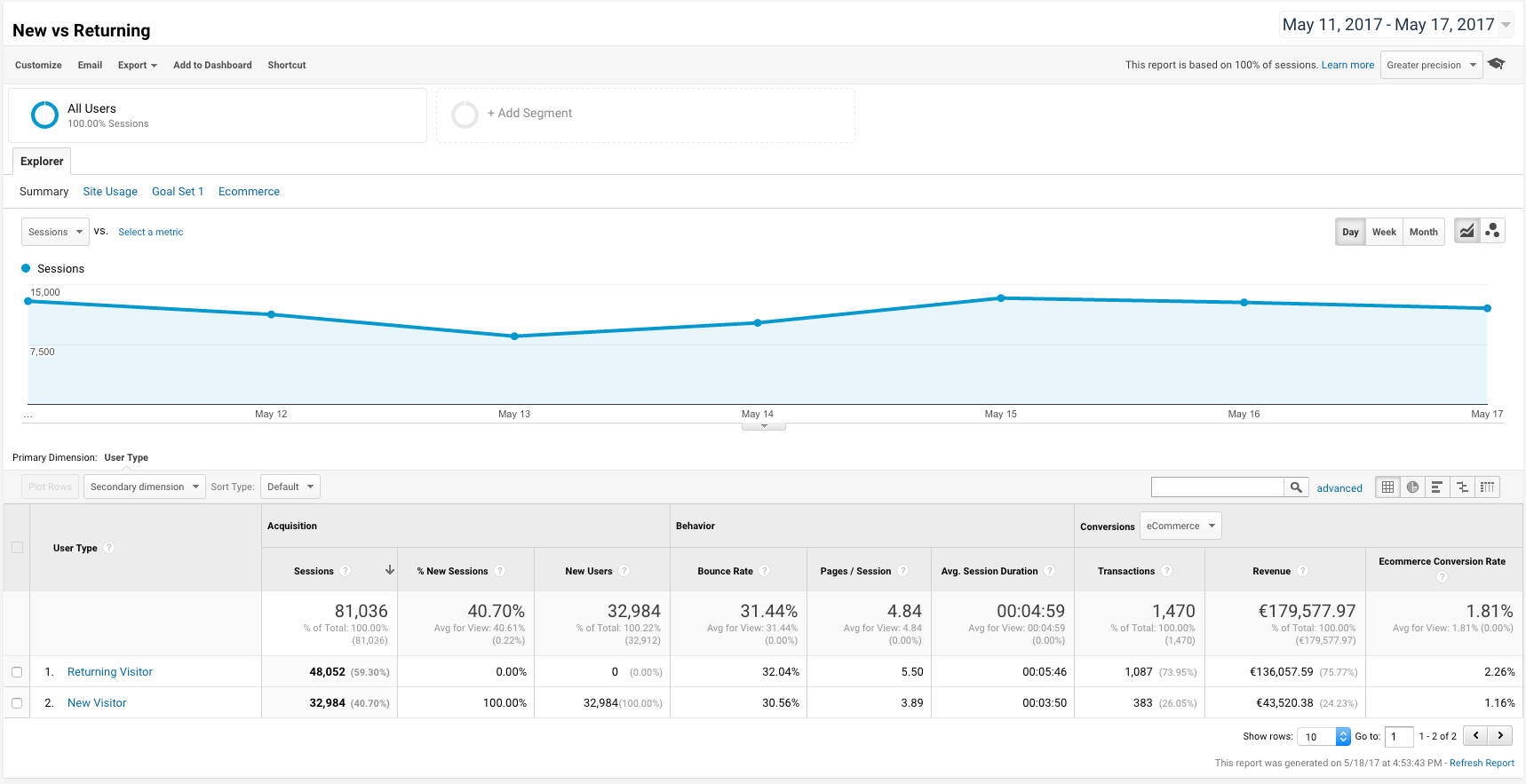
This section will provide you with a detailed overview of how new customers (first time visitors), and returning visitors (visitors who have visited your store previously) interact with your online store and your products. You’ll be able to monitor if there are any major differences in the conversion rates, which will help you to understand how many points of contact you need to make with some returning visitors before they make a purchase. If you find that the new customers have a high conversion rate then you could try adding more impulse buys to your store — this will help take advantage of these customers.
Shopping Behavior
Your shopping behavior section of Google Analytics will provide you with insights about some areas of your store which you’re capable of improving. You can access this information by selecting ‘Conversions’ on the left side of Google Analytics and selecting ‘Ecommerce’. From here you’ll be able to view:
- Total Sessions – Total number of visits that your store received.
- Sessions with Product Views – Number of store visits which involved a visitor landing on a product page.
- Sessions With Add to Cart – Number of store visits which involved a visitor adding a product to their cart.
- Sessions with Transactions – Number of store visits which involved a visitor purchasing a product.
- No Shopping Activity – Number of store visits which resulted in no shopping activity.
- No Cart Addition – Number of store visits which involved visitors looking at products, but failing to add the product to their carts.
- Cart Abandonment – Number of store visits which involved visitors adding a product to their cart, but failing to complete the transaction.
- Check Out Abandonment – Number of store visits which involved the visitor getting the the check out and leaving before completing the transaction.
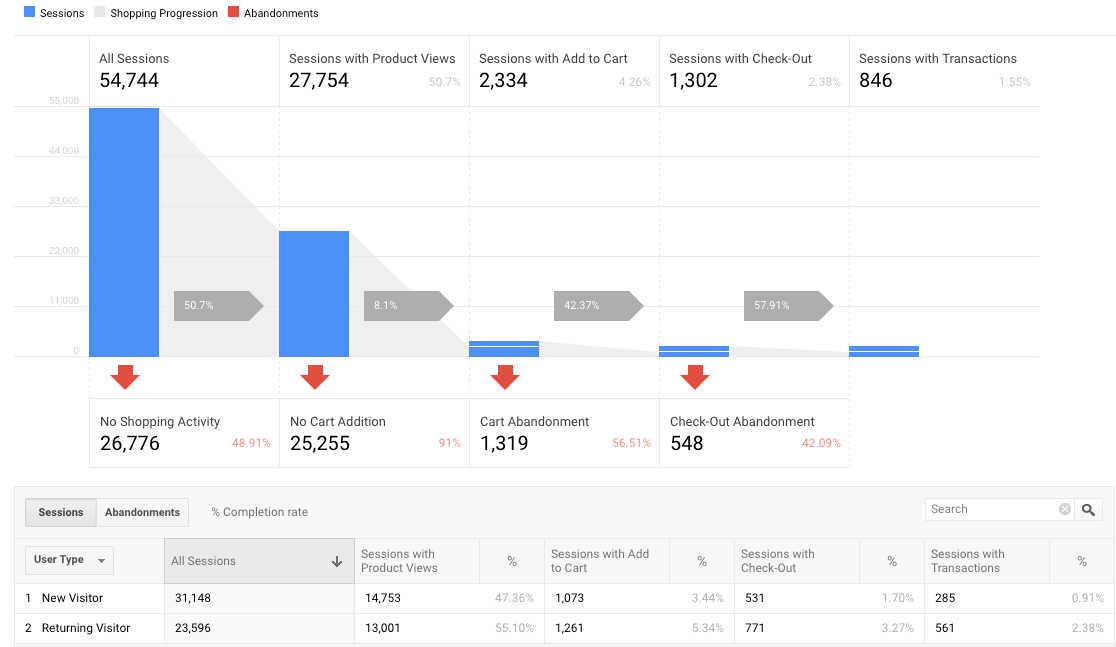
It’s critical that you take some time to review this data and analyze if there are any striking patterns present. Can you see if there are any noticeable drops in user engagement which you can attribute to a particular aspect of your store? For example, if you find that there is a huge drop off at the Check Out Abandonment stage then this may be caused by the payment provider which you’re using. If you have a lot of international customers then it’s a good idea to use a qualified international payment provider, like Paypal, or Shopify Payments — this will help avoid customers abandoning the sale at the checkout stage. Take time to review these figures, as they will offer you actionable insights which you can use to improve your store.
Transaction Performance
The transaction performance section in Google Analytics will help you to better understand your ecommerce business’ conversion rate. Your conversion rate is a great metric to measure — it’ll show you the percentage of people who visit your store and actually make a purchase. You can access this from selection the ‘Conversions’ tab on the left side of Google Analytics, then ‘Ecommerce’, and finally ‘Transactions’.
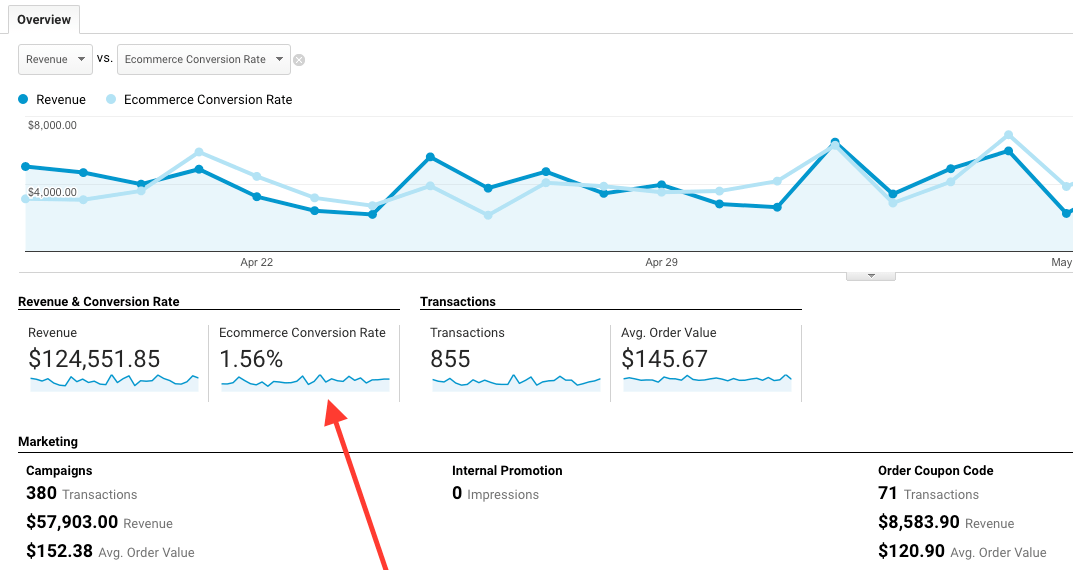
When you’re analyzing your conversion rate it’s critical to remember that the average conversion rate for an ecommerce business is around 2%, so don’t be disheartened if you find that yours is lower. You may find that your conversion rate is higher if you’re running a niche store, as there are less stores competing with you for traffic and conversions. On the other hand, if you’re running a store in a competitive niche, like a T-shirt business, then you may see that your conversion rate drops just below 2%.
Aim to increase your conversion rate over time — this will enable you to generate more revenue, which you can then use to grow your ecommerce business even further. Your conversion rate might not change overnight, but you can use the valuable information from Google Analytics to guide you towards this goal.
Checkout Behavior
This section of Google Analytics will help you to understand how customers behave when they’re engaging with your store’s checkout process. You can access the checkout behavior analytics by selecting ‘Conversions’ on the left side, then clicking ‘Ecommerce’ and ‘Checkout’.
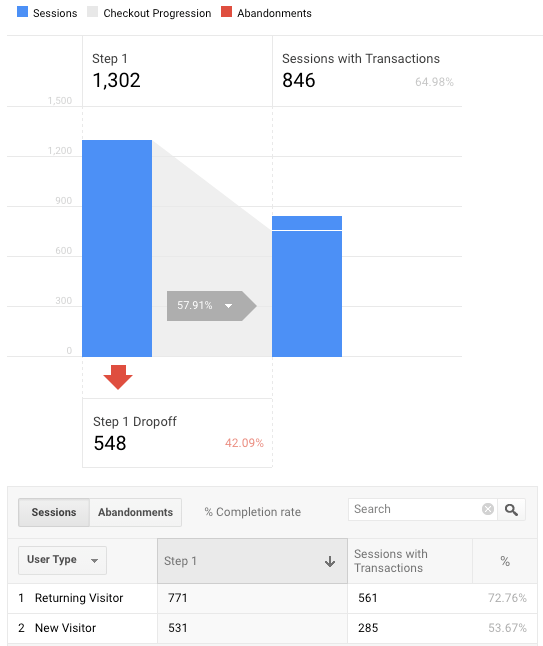
If your ecommerce store’s checkout process involves multiple stages for setting up a payment method, choosing a shipping method, and creating an account, you’ll be able to analyze how your customers behaved, and at what point they abandoned the sale. If you find that there is a significant drop at a certain stage in your checkout process then take some time to assess why this is happening. Of course, if your store has a one-page checkout then you’ll simply be able to view the amount of customers who have arrived at this page.
Customers who have landed on the checkout page are clearly interested in both your products and your store. When you refine this process you’ll ensure a better user experience for your customers, and you’ll be able to secure more sales, which ultimately helps your business generate more profit.
Product Performance
This section of Google Analytics will list all of the products which you sell in your ecommerce store, and will allow you to highlight the top performers. You’ll be able to see useful metrics here like page views, sessions, time spent on page, and conversions. You can access this section of Google Analytics through ‘Conversions’, then select ‘Ecommerce’ and then select ‘Product’.
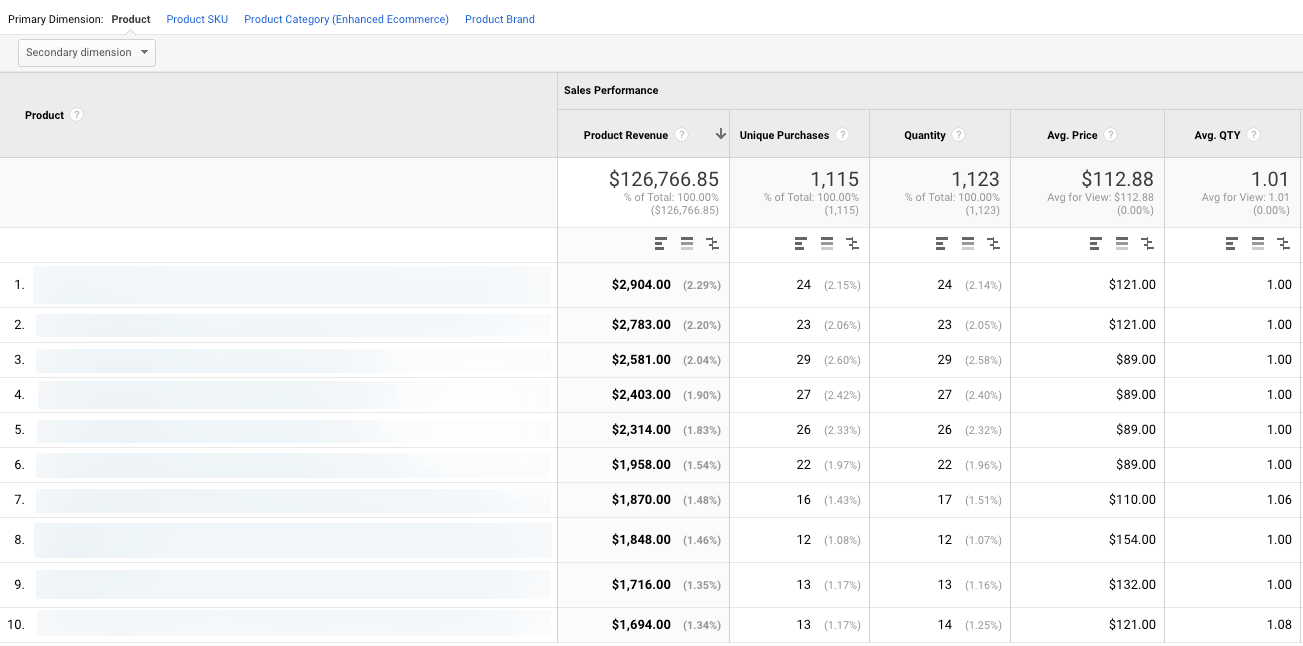
Not only will your product performance statistics help you to understand how customers interact with your inventory, it can also help you with your marketing efforts. If you’ve been pushing customers towards certain products, and you see that they have a low conversion rate, you may be better off using different products for your marketing campaigns. On the other hand, if you find that specific products are converting well without any marketing efforts, you may want to create some campaigns to boost your sales.
Start Using Google Analytics Today
Now you know everything that you need to start using Google Analytics for your store today, congratulations! Google Analytics will enable you to make data-informed decisions about your store, and it’ll help you grow your store into a successful business.
We’ve only really scratched the surface with the potential that Google Analytics offers to your ecommerce business. If you’ve got any questions about Google Analytics, or you have any tips from your own experiences with the tool then let us know in the comments below. We’re happy to help you on your ecommerce journey.
Want to learn more?
- How to Use Twitter Analytics to Improve Your Engagement
- How to Sell and Advertise on Google
- Google Adwords Tutorial: A Step-by-Step Guide to Your First Campaign
- Facebook Ads Tactics That’ll Skyrocket Sales!
Is there anything else you’d like to know more about and wish was included in this article? Let us know in the comments below!



